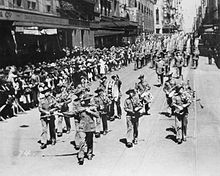2/19th Battalion (Australia)
| 2/19th Battalion | |
|---|---|
Second World War
| |
| Commanders | |
| Notable commanders | |
The 2/19th Battalion was an
History
Raised for service during

Individual and collective training was undertaken at several locations – Walgrove, Ingleburn and Bathurst – as the troops of the newly formed 8th Division were prepared for future employment in the Middle East, where it was planned that they would join the other 2nd AIF divisions that had already been deployed. This had only partially been completed by early 1941, when the Australian government agreed to a British request to dispatch Australian troops to bolster the British garrison in Malaya, amidst growing concerns about a war with Japan in the Pacific.[5] They embarked from Sydney for Singapore aboard the HMT Queen Mary on 2 February 1941, disembarking on 18 February,[6][7] after which they undertook jungle training in southern Malaya, around Seremban and Port Dickson, until September 1941. They then moved to Jemaluang to build defences on the east coast of the Malayan Peninsula, after a brief stay at Kluang.[3]
Following the

Arriving late on 17 January, the 2/19th's arrival helped briefly stabilise the situation on the west coast, allowing the 2/29th and the
In late January, the battalion withdrew across the
Following the surrender of Japan the survivors were liberated in August 1945. The battalion was disbanded later in 1945, having sustained the highest casualties of any Australian Army unit during the war, sustaining 620 dead and 197 wounded.
Battle honours
The 2/19th Battalion received the following battle honours:
- Malaya 1941–1942; Johore; The Muar; and Singapore Island.[3]
In 1961, these battle honours were entrusted to the 19th Battalion, and they are now maintained by the 1st/19th Battalion, Royal New South Wales Regiment.[12][13]
Commanding officers
The following officers commanded the 2/19th Battalion during the war:[3][14][15]
- Lieutenant Colonel Duncan Maxwell (1940–41);
- Lieutenant Colonel Charles Anderson (1941–42);
- Lieutenant Colonel Andrew Robertson (1942)
References
- Footnotes
- Citations
- ^ Palazzo 2004, p. 94.
- ^ Long 1952, p. 51.
- ^ a b c d e f g h i j k l "2/19th Battalion". Second World War, 1939–1945 units. Australian War Memorial. Archived from the original on 19 December 2013. Retrieved 18 December 2013.
- ^ Long 1952, pp. 321–323.
- ^ Morgan 2013, p. 6.
- ^ "Bucknell, Herbert Graham: Service Number NX35579, p. 3 of 6". National Archives of Australia. Retrieved 27 September 2019.
- ^ "Anderson, Charles Groves Wright: Service Number NX12595, p. 11 of 25". National Archives of Australia. Retrieved 27 September 2019.
- ^ "Anderson, Charles Groves Wright: Service Number NX12595, pp. 7 and 13 of 25". National Archives of Australia. Retrieved 27 September 2019.
- ^ Morgan 2013, pp. 8–10.
- ^ Morgan 2013, p. 9.
- ^ Blackburn & Hack 2007, p. 39.
- ^ Festberg 1972, pp. 28 & 81.
- ^ "The 1st/19th Battalion, Royal New South Wales Regiment History". Department of Defence. Archived from the original on 4 August 2008. Retrieved 22 July 2009.
- ^ "2/19 Infantry Battalion: Appointments". Orders of Battle. Retrieved 2 January 2016.
- ^ Pratten 2009, pp. 325–326.
- Bibliography
- Blackburn, Kevin; Hack, Karl, eds. (2007). Forgotten Captives in Japanese-Occupied Asia. London: Routledge. ISBN 9780415426350.
- Festberg, Alfred (1972). The Lineage of the Australian Army. Melbourne, Victoria: Allara Publishing. ISBN 978-0-85887-024-6.
- OCLC 18400892. Retrieved 22 December 2015.
- Morgan, Joseph (2013). "A Burning Legacy: The 'Broken' 8th Division". Sabretache. LIV (3). Garran, Australian Capital Territory: Military Historical Society of Australia: 4–14. ISSN 0048-8933.
- Palazzo, Albert (2004). "Organising for Jungle Warfare". In Dennis, Peter; ISBN 978-0-646-43590-9. Archived from the originalon 9 March 2016.
- ISBN 978-0-521-76345-5.
Further reading
- Newton, R.W. (1975). The Grim Glory of the 2/19 Battalion A.I.F. Sydney, New South Wales: 2/19 Battalion A.I.F. Association. ISBN 090913300X.

